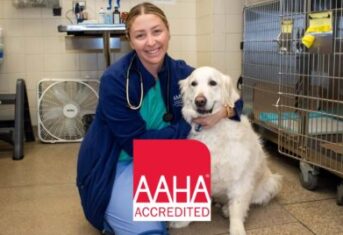How is Pet Food Made? With Lots of Safety Precautions!

How is Pet Food Made? With Lots of Safety Precautions!
I recently experienced a first in my veterinary career: I was invited to tour a pet food manufacturing plant, along with a number of veterinary colleagues. The plant manufactures only dry food and treats using four extrusion lines and three packaging lines. (Manufacturing canned food requires an entirely different plant.) I went with my journalistic cap on, and I’ll detail my experience below.
Pet Food Manufacturing is No Small Operation
The plant is 350,000 square feet. I will confess I had no idea how big that really was. Think the biggest IKEA you have ever seen. However, instead of pallets of dressers and bookshelves, there were two-story-high shelves filled with pallets of colorful pet food bags.
Meat comes into one side of the plant in 2000-pound frozen cubes, which are about the size of a Smart Car. Meat cubes are stored in a refrigerator or freezer, each about the size of a basketball court. All other ingredients come into the other side of the plant. We saw fish oil containers similar in size to the meat cubes and enough L-lysine to provide this essential feline amino acid to every cat on the planet for years.
A Good Manufacturing Process (GMP) Facility
This plant is a GMP facility. A GMP facility is one that follows very specific manufacturing processes set out by the United States Food and Drug Administration. It has defenses against the entry of unwanted people, animals and insects to protect the integrity of the pet food being prepared. All doors close automatically to prevent unauthorized entry. Everyone on the tour had to sign in and out of the facility.
Ensuring Pet Food Safety
As you can see in the photo accompanying this blogpost, we had to wear more protective clothing and devices then we would have worn during the height of the COVID pandemic. Our attire for the tour was no different than that of the plant workers, except for our visitor smock. Hairnets, beardnets, ear plugs, protective footwear, and the ultimate fashion statement, an orange safety helmet, were required. Our hands were automatically washed before entry, and the soles of our shoes scrubbed multiple times to prevent us from carrying any contaminants around the plant.
I also learned about special Band-Aids detectable by metal detectors that were required for use by any worker with a cut or scratch. These “metal detectable bandages” are common in food manufacturing plants, food service areas and restaurants to alert staff of any bandages that may have fallen off into the food. Their bright blue color is easily visible, and the bandages have a metal strip to alert metal detectors during the mandatory x-ray every bag of pet food undergoes to screen for contaminants.
Product Safety is Priority
The plant was divided into a red zone and a green zone with different functions and rules. The red zone is where the raw materials enter, are stored, mixed and put into the kibble extruder. The green zone is where the kibble is bagged, put on pallets and readied for shipping. At every step of the process, the raw materials, the product, and the bags are tested to ensure there is no contamination with microbes, toxins or metal; the food meets the nutritional profile of the formulation; and the food continues to meet the nutrient profile for the duration of its shelf-life. Samples of every lot are retained in case a problem is detected with the food and further testing is required. All this to meet the nutritional needs of your favorite fur person.
Wondering how to choose the best food for your pets? Here are my 2022 suggestions.

































